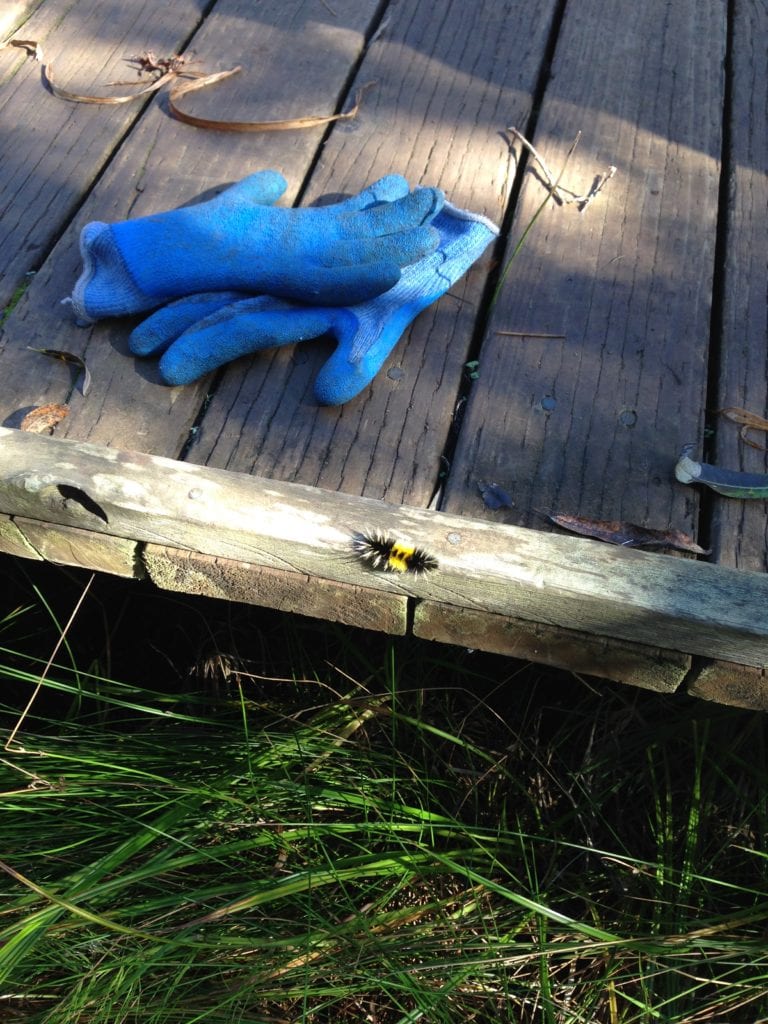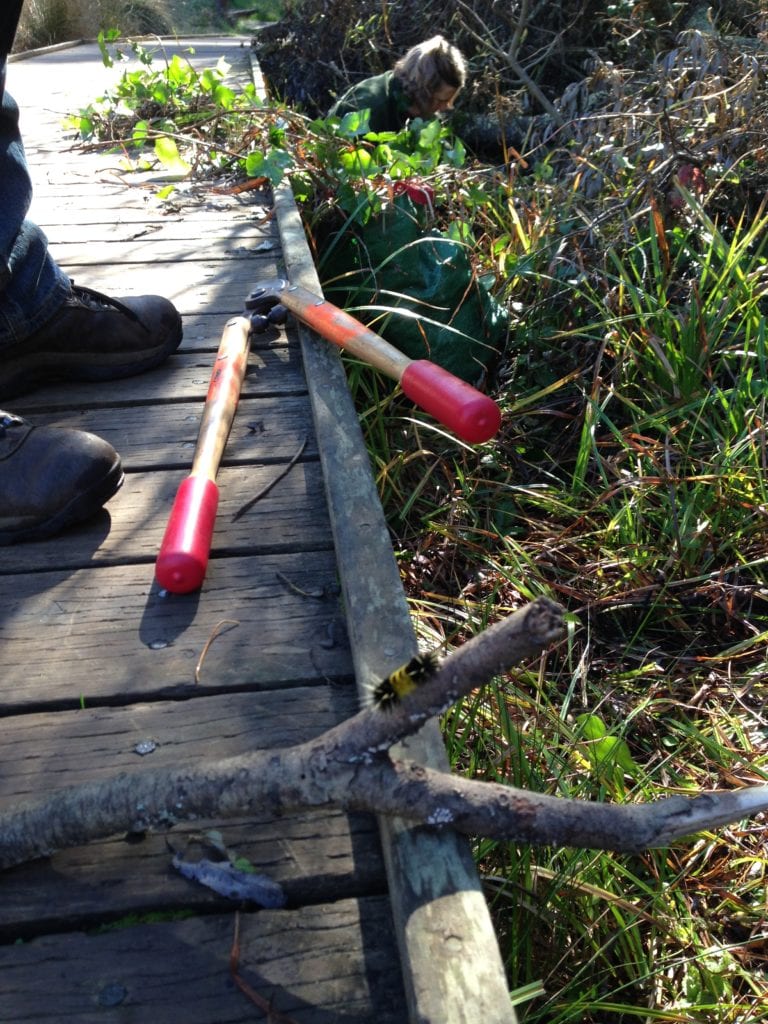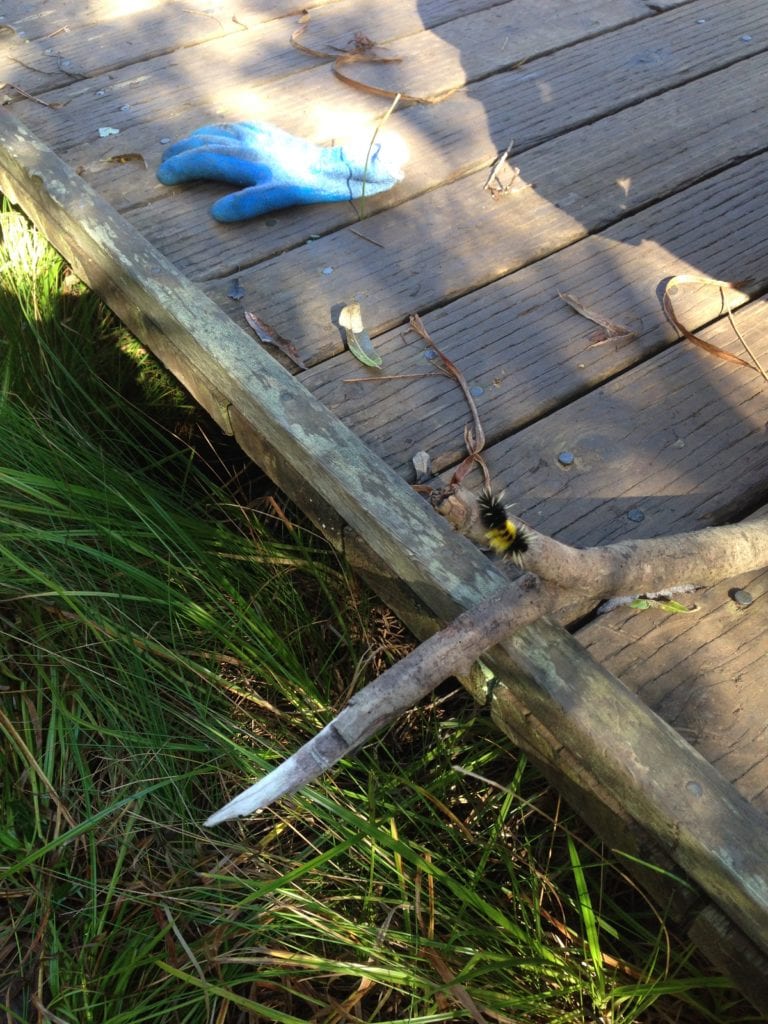
Story and photos by Murray Schneider
Want to know if the winter will be mild or severe, or if the December rains will continue into April. You need go no farther then Glen Canyon’s boardwalk, which transverses a natural seep only a few yards north of Glenridge Nursery School.
That’s what four Friends of Glen Canyon Park volunteers did on October 26, all in the service of thwarting tangles of English ivy from encroaching upon the east side of the boardwalk. Left alone, the tendrils threatened to choke rare California yellow-eyed grass, which thrives along the marshy slope above the boardwalk.
Silhouetted by both pumpkin spider webs and Glenridge nursery school children who skipped above them, the volunteers worked for three hours only a few feet below the boardwalk.

Dog walkers and joggers passed above them, skirting loppers, mattocks, gardening gloves, and pop-up bags. The bags housed leaf litter scheduled for sacrifice among arroyo willow cloaked in scaly lichen.
While removing the ivy the volunteers came upon a Woolly Bear caterpillar, a storied weather predictor. The California insect, in the interest of full disclosure, has nowhere near the gravitas as that all knowing Pennsylvania groundhog, an annual spring weather predictor after leaving its winter burrow.
But, as folklore has it, the Woolly Worm, as it is known from as far off as Mexico and throughout North America, is a crawling weathervane with a legendary reputation for forecasting winter weather.
 No need to switch on the weather channel or consult a Farmer’s Almanac.
No need to switch on the weather channel or consult a Farmer’s Almanac.
Simply learn how to “read” Glen Canyon’s Woolly Bear caterpillar!
Our Glen Park saga has its own yearly cycle.
Each fall, the curvy Woolly Bear emerges from its egg.
That’s what it did this October, snuggling among willow boughs along Islais Creek, the sound of its water muffled since fall rains were intermittent.
 The Woolly Bear overwinters in its caterpillar form, seeking sanctuary beneath bark or inside cavities of logs until the spring when it pupates, emerging from its pupa as a full winged tiger moth.
The Woolly Bear overwinters in its caterpillar form, seeking sanctuary beneath bark or inside cavities of logs until the spring when it pupates, emerging from its pupa as a full winged tiger moth.
But it’s in its caterpillar stage that the wiggly invertebrate allegedly excels as a weather prognosticator.
You simply need to decipher what it’s prophesying.
It all has to do with its scratchy segmentation.
The Woolly Bear has 13 distinct segments, each rusty brown or black.
The Glen Canyon archetype, however, boasts a bright yellow and black torso.
The wider the rusty brown, or in the canyon specimen’s case, the wider the luscious yellow, the milder the coming winter will be. The blacker the body the blustery the winter.
Nothing complicated. Reach for a ruler; pick up a tape measurer. Then determine the severity of the weather.
Fable doesn’t make correct science, though. And it would have been futile convincing the pre-school children trooping above four kneeling neighborhood Rec and Park volunteers that each needed to don raincoats and galoshes this January or February based upon the number of black bristles coating the fuzzy crawler.
The kids continued skipping by. Sun winked over a volunteer’s shoulders while water continued saturating the knees of his jeans. In front of him poison oak shoehorned among strands of horizontal willow, which he managed to avoid.
The Woolly Bear inched along a willow limb that straddled the boardwalk, squiggling from the children whose teachers nudged them closer to Alms Road.
The same volunteer lifted the Woolly Bear, cradling it in his palm, rescuing it from the children’s sneakers. He threaded his way to the sacrifice pile and released it. It moved a few inches until it was safely camouflaged beneath a clump of ivy leaves, willow twigs and blackberry stalks.
Folk tale doesn’t make for good science.
But the Woolly Bear makes for good serendipity, arbitrary and imprecise as it may be.
Each evening the news broadcasts reliable weather reports. Our technical soothsayers are sophisticated computer simulations. We bundle it with smartphone wizardry and rely upon each for accurate daily information.
With a nod to Punxsutawney Phil, though, on one morning this October, wouldn’t it have been fitting to glean the weather from a bristly Glen Park bug tucked beneath a blanket of detritus only a few feet from a creek called Islais?
For those children on an outing to the City’s 70-acre natural area, and for the child in each one of the four Recreation and Park Department’s Natural Areas Program volunteers that would have been cool.
As cool as winter’s weather that may or may not visit us depending on how you read a Glen Canyon crawling critter.